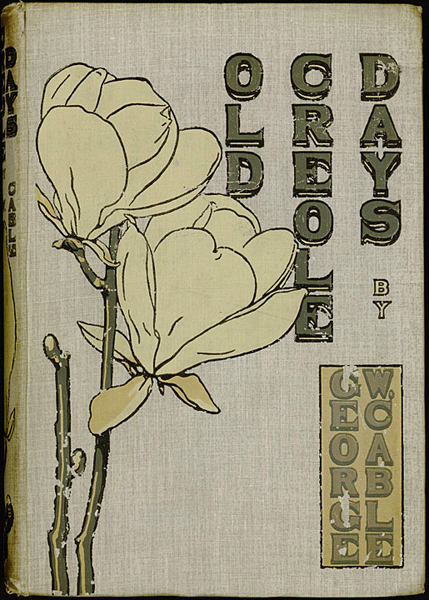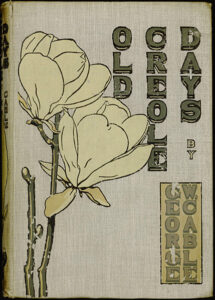Creoles in Literature
Representations of Louisiana’s Creole population are as varied and complex as the definition of the term itself.

Courtesy of Louisiana State Museum
“Old Creole Days”. Charles Scribner's Sons (Publisher)
Fepresentations of Louisiana’s Creole population are as varied and complex as the definition of the term itself. Whether in nineteenth-century local color fiction or twentieth-century detective novels, writers have often used Creole characters to convey their understanding of the state’s complex ethnic heritage. While some writers, particularly in the nineteenth century, insisted that the term applied to white aristocrats only, others use Creole characters to explore the complexities of racial and class relations within Louisiana.
Defining Creole
Originally, the term Creole meant anyone born in the New World to parents who were from Europe—particularly France or Spain—or Africa, most of whom spoke French. During the French and Spanish colonial periods, in other words, the term did not reflect racial categories. Similarly, at the time of the Louisiana Purchase (1803), the term was generally used to distinguish between Louisianans born in the state and those who immigrated from elsewhere. After the Civil War (1861–65), however, the term became racially charged as white Louisianans insisted that it only applied to those of European lineage. Around the same time, the term “Creoles of color” arose to describe black Louisianans with a mixed racial heritage. Even now, at the beginning of the twenty-first century, the term continues to inspire debate.
Creoles in Nineteenth-Century Literature
Following the Civil War, Louisiana played a central role in the local color fiction that was popular during the period. Writers such as Grace King, Lafcadio Hearn, and Ruth McEnery Stuart frequently set their fiction in the Pelican State and featured Louisianans in their stories. Creoles, along with Cajuns and free people of color, embodied a blend of characteristics that were regionally distinct and relatively unknown to most readers. As local color writers attempted to explain regional locales and peoples to the rest of the nation, they often promoted the post-Civil War definition of Creoles as whites only. Some claimed Creole superiority over African Americans, Acadians, and even Américains.
In his literary response to the competing definitions of Creole, The Grandissimes (1880), writer George Washington Cable infuriated New Orleans Creoles by maintaining that the Creole community was not only proud and stubbornly opposed to progress and change, but also racially mixed. Cable’s Old Creole Days (1879), Madame Delphine (1881), and Strange True Stories of New Orleans (1888) also questioned notions of racial purity and criticized archaic Creole notions of superiority perpetuated by popular myths.
Cable’s speeches, essays, and fiction inspired Grace King, among others, to write her own version of the Creole past in works such as Monsieur Motte (1888) and Balcony Stories (1893), which depict a more romantic notion of Creole history and relate the devastating effects of the Civil War on this community. King’s work was influenced by Charles Gayarré, the New Orleans historian who helped create the myth that Creoles were exclusively white, chivalrous, and genteel—a response, at least in part, to the publication and growing popularity of Cable’s work.
Kate Chopin also featured Louisiana Creoles prominently in her fiction, including Bayou Folk (1894),A Night in Acadie (1897), and The Awakening (1899). Capturing the complexity and confusion of racial definitions in Louisiana, Chopin’s Creole characters vary considerably. In the story “Neg Creole,” for example, she portrays a community of Creoles of color, while the Creoles in The Awakening were wealthy New Orleans elite.
Though born in Greece, writer Lafcadio Hearn also contributed to the debate, exploiting the unique and varied Creole culture in his stories about New Orleans. In addition, Chita: A Memory of Last Island (1889), Hearn’s novel about the hurricane that destroyed Last Island, follows the life of a Creole girl as she miraculously survives the destruction and finds a new home away from her privileged New Orleans family. By the end of the nineteenth century, Alice Dunbar-Nelson offered yet another image of Creoles based on her experiences as a Creole of color in New Orleans. She represents the multiracial Creole community in Violets and Other Tales (1895),The Goodness of St. Rocque and Other Stories (1899), and her 1917 essay, “People of Color in Louisiana.”
Creoles in Twentieth- and Twenty-First-Century Literature
During the twentieth century, the debate over the meaning of Creole continued to rage and representations of Creoles in literature continued to be as varied and as racially indeterminate as ever. New York native Edward Laroque Tinker wrote Toucoutou (1928), in which a Creole woman of color passes for white in nineteenth-century New Orleans. Obviously influenced by the time he spent in New Orleans early in his career, William Faulkner conveys some of the racial ambiguity of the New Orleans Creole community in his character Charles Bon, the rejected son in Absalom, Absalom! (1936). Writer and folklorist Lyle Saxon wrote Children of Strangers (1937), a novel set near Cane River in central Louisiana and based on the community of Creoles in Isle Brevelle who lived there. In more recent years, Lalita Tademy returns to the subject of the Cane River Creoles in her novel Cane River (2001).
Finally, Ernest Gaines’s novels and short stories offer a more complex picture of African American life, capturing the tensions between Creoles and blacks still evident in 1970s Louisiana. His first novel, Catherine Carmier (1964), conveys not only this divide but also the competition between Creole and white farmers as “progress” sweeps across rural Louisiana. The Autobiography of Miss Jane Pittman (1971) and A Gathering of Old Men (1983) also include Creole characters. In the latter, a Creole character who generally sets himself apart from other blacks finally joins with them to oppose racism and injustice. Anne Rice has joined this illustrious group with her New Orleans fiction, including The Feast of All Saints (1979), set in nineteenth-century Creole New Orleans.
Writers of Louisiana detective fiction have also added a dimension to the representation of Louisiana Creoles with the introduction of Creole detectives. Though Barbara Hambly’s Benjamin January series, David Fulmer’s Valentine St. Cyr series, and Robert Skinner’s Wesley Farrell series explore different eras of New Orleans history, they reveal the city’s cultural and racial divides and their significance to Creoles of color in the past.
